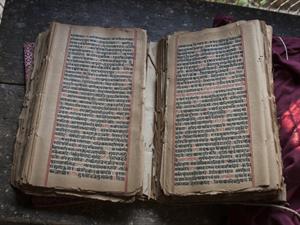
PUMPA - SMART LEARNING
எங்கள் ஆசிரியர்களுடன் 1-ஆன்-1 ஆலோசனை நேரத்தைப் பெறுங்கள். டாப்பர் ஆவதற்கு நாங்கள் பயிற்சி அளிப்போம்
Book Free DemoIron and the Revolution:
The discovery of Iron was considered as one of the watershed moments in the history of humankind. The people of Gangetic valley during the latter half of the Vedic period were well-acquainted with the usage of Iron.
The later Vedic period in the northern parts of India witnessed the development in the lifestyle of people as they slowly began to perform activities like iron casting, and make iron objects for their daily use.
The usage of iron was also seen in agriculture as equipment like ploughs and sickles were made of iron.
Urbanisation during the Iron Age:
The Urbanisation that took place during the later Vedic period is of high significance, as this was the first period of settled living among the community of people.
The advent of iron during this period divided Urbanisation into two ways.
People became experts in the blacksmith profession, pottery making, weaving clothes etc. They lifted their standard of living with their profession.
Another set of people stayed close to the iron resources and earned a living by creating a market for raw iron and completed goods made of iron.
The emergence of new Towns and Kingdoms:
The concentration of new markets paved the way for the emergence of towns in the future like Rajgriha, Kaushambi and Vaishali in North India.
Usage of Iron for making weapons found great patrons among the warrior class as the weapons made of Copper and Bronze are sub-standard compared with the one’s made with iron.
The weapons of Iron were used in wars and conquests and thus led to the expansion of territories, which led to the emergence of Kingdoms like Magadha and Avanti in future.
The Post-Vedic Religion:
The Vedic Period also witnessed the rise of Vedas, Brahmanas, Aranyakas and the Upanishads to enlighten the people of the upper Gangetic Plains during 1000 – 600 BCE.
1. Vedas:
The word Veda is derived from the root word “Vid” meaning “to know or superior Knowledge”. It contains four Vedas, namely:
Rig Veda: Considered the oldest of the Vedas, which contains 1028 hymns written in 10 books about various gods. Books 2-7 are known as family books.
Yajur Veda: Speaks about the rules that are to be followed in a Socio-Political life.
Sama Veda: It is known as the Books of Chants or Music, containing \(1810\) hymns.
Atharva Veda: Also Known as the Book of Magical and Mystical spells, which also speaks about Medicine.

The Rig Vedic text
2. Brahmanas:
These are literary sources that speak about the sacrifices and prayers. Tandyamaha Brahmana is considered to be the oldest among the Brahmanas.
Aranyakas: These are part of Brahmans and are present in the final parts of the texts. Aranyakas are also known as “Forest books”.
3. Upanishads:
The word Upanishad means “to sit near someone”. These are philosophical texts that deal with the Soul of the Human, and contains 108 texts among those the “Chandogya and Brihadarnayaka are the oldest ones”.
It is also known as Vedangas (end of Vedas) as it denotes the final phase of the Early Vedic Period.
Reference:
The Ric Vedic text - bodom / Shutterstock.com